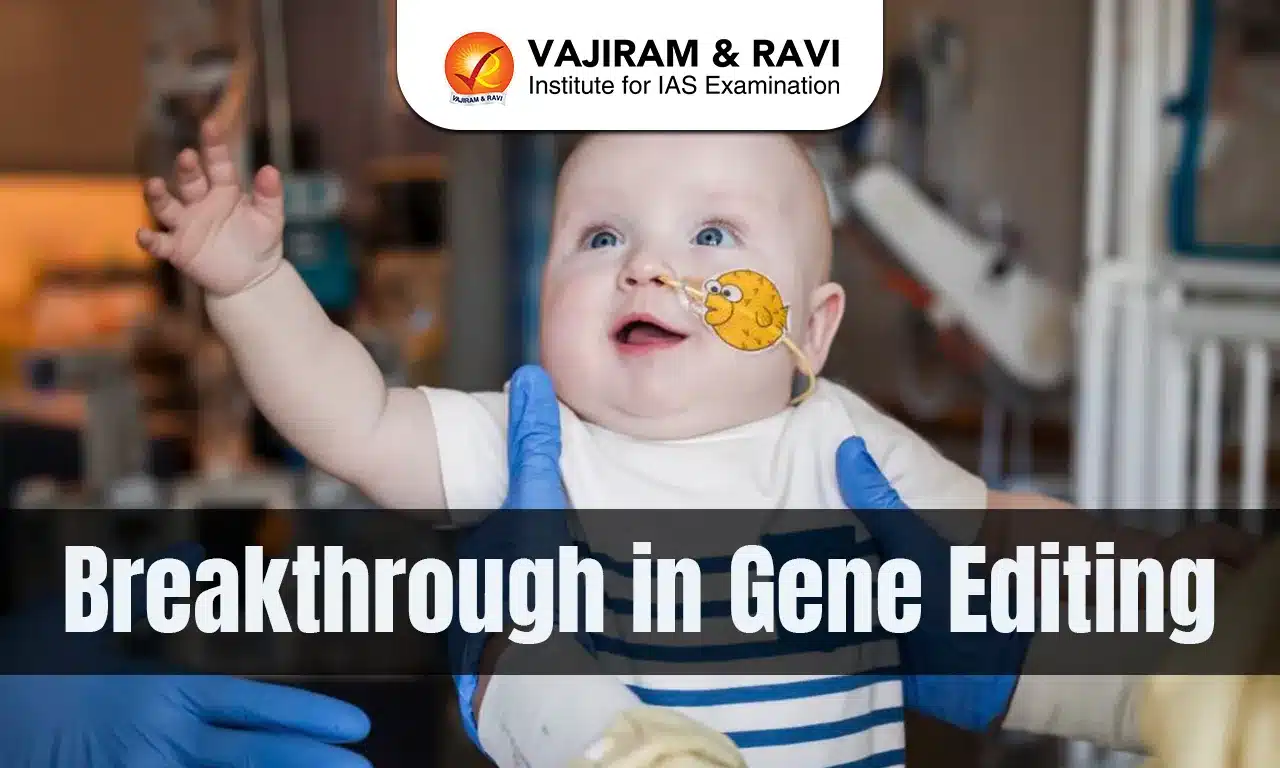Breakthrough in Gene Editing Latest News
- A nine-month-old boy, Kyle “KJ” Muldoon Jr., became the first known human to be successfully treated using custom base editing therapy, a precise form of gene editing.
- KJ suffers from CPS1 deficiency, a rare genetic disorder causing toxic ammonia buildup in blood.
Gene Editing Breakthrough
- What is the CPS1 deficiency? Carbamoyl Phosphate Synthetase I (CPS1) deficiency prevents the breakdown of nitrogen in the body, and leads to hyperammonemia, a potentially fatal condition.
- Treatment innovation: Scientists from the University of Pennsylvania and Children’s Hospital of Philadelphia used base editing, an advanced technique derived from CRISPR-Cas9.
CRISPR and its Mechanism
- What is CRISPR?
- Stands for Clustered Regularly Interspaced Short Palindromic Repeats (CRISPR), it is an immune system found in microbes such as bacteria which fights invading viruses.
- When a virus infects a bacterial cell, CRISPR helps to establish a memory (a genetic one, not in the form of antibodies like in humans).
- When a virus enters a bacterial cell, the bacterium takes a piece of the virus’s genome and inserts the DNA into its own genome.
- CRISPR then produces a new “guide” RNA, which directs an enzyme (a type of protein) called Cas9 to act like “molecular scissors” to cut and eliminate the virus DNA.
- Development of CRISPR-Cas9 technology: Pioneered in 2012 by Jennifer Doudna and Emmanuelle Charpentier, which earned them the Nobel Prize for Chemistry (2020).
Working of CRISPR-Cas9 Gene Editing
- The first task for the gene-editing tool is to identify the abnormal DNA sequence behind a patient’s ailment.
- Once the bad DNA is located, scientists create a guide RNA attached to a Cas9 enzyme, which is then introduced to the target cells of the patient.
- The guide RNA recognises the bad DNA sequence, then the Cas9 enzyme cuts the DNA at the specified location in a process called a “double-strand break” (since the cut is made on both strands of the DNA).
- To prevent the regrowth of bad sequence, scientists also supply the correct DNA sequence after the “cutting” process which is meant to attach itself to the broken strands of DNA.
Base Editing – The Next-Gen CRISPR
- Key features:
- Base editing and CRISPR-Cas9 differ significantly in how they modify DNA.
- Unlike CRISPR-Cas9, base editing does not make a double-strand break.
- Rather, it enables targeted single-base conversions with the help of a Cas9 enzyme fused to a base-modifying enzyme.
- This allows scientists to fix mispairing of the bases by changing one specific base.
- Application in KJ’s case: Specific mispaired base responsible for CPS1 was corrected.
- Advantages:
- Base editing system works like a pencil and eraser, unlike the scissors and glue of CRISPR, and doesn’t require foreign DNA insertion.
- Precision, compact delivery, and fewer components.
- Easier to transport in viral vectors or other delivery systems.
Ethical, Economic and Regulatory Challenges
- Accessibility and cost: Prohibitively expensive – likely in hundreds of thousands of dollars. KJ’s treatment is funded by research institutes and biotechnology firms.
- Scalability issues:
- Treatment was personalised; not applicable to other patients.
- Commercial disincentive for pharmaceutical companies due to high cost and customisation needs.
- Regulatory bottlenecks: Complex approval mechanisms, especially in countries like India. Need for reform in bioethics, policy, and governance frameworks.
Conclusion – Hope Amidst Challenges
- KJ’s case marks a milestone in personalised medicine.
- Despite its potential to revolutionise treatment of rare genetic diseases, base editing remains constrained by cost, customisation, and policy hurdles.
- Future success will depend on efforts to make advanced biotechnologies affordable, scalable, and ethically regulated.
Breakthrough in Gene Editing FAQs
Q1. What is CPS1 deficiency, and how does it affect the human body?
Ans. CPS1 deficiency is a rare genetic disorder that leads to the accumulation of toxic levels of ammonia in the blood due to a defect in the urea cycle enzyme Carbamoyl Phosphate Synthetase I.
Q2. How does CRISPR-Cas9 gene-editing technology function at the molecular level?
Ans. CRISPR-Cas9 uses a guide RNA to direct the Cas9 enzyme to a specific DNA sequence, where it introduces a double-strand break to remove or replace faulty genetic material.
Q3. What is base editing, and how is it different from CRISPR-Cas9?
Ans. Base editing is a precision gene-editing tool that alters a single DNA base without making double-strand breaks, unlike CRISPR-Cas9, which cuts both DNA strands and requires insertion of foreign DNA.
Q4. Why is the application of base editing in clinical treatment currently limited?
Ans. The clinical use of base editing is limited by high costs, customisation for individual patients, regulatory hurdles, and lack of scalability for mass application.
Q5. Discuss the ethical and regulatory challenges in implementing personalised gene-editing therapies like base editing in India.
Ans. India faces ethical concerns over genetic modifications and regulatory bottlenecks due to bureaucratic red tape, making the clinical implementation of personalised therapies like base editing difficult.
Source: IE
Last updated on June, 2025
→ UPSC Notification 2025 was released on 22nd January 2025.
→ UPSC Prelims Result 2025 is out now for the CSE held on 25 May 2025.
→ UPSC Prelims Question Paper 2025 and Unofficial Prelims Answer Key 2025 are available now.
→ UPSC Calendar 2026 is released on 15th May, 2025.
→ The UPSC Vacancy 2025 were released 1129, out of which 979 were for UPSC CSE and remaining 150 are for UPSC IFoS.
→ UPSC Mains 2025 will be conducted on 22nd August 2025.
→ UPSC Prelims 2026 will be conducted on 24th May, 2026 & UPSC Mains 2026 will be conducted on 21st August 2026.
→ The UPSC Selection Process is of 3 stages-Prelims, Mains and Interview.
→ UPSC Result 2024 is released with latest UPSC Marksheet 2024. Check Now!
→ UPSC Toppers List 2024 is released now. Shakti Dubey is UPSC AIR 1 2024 Topper.
→ Also check Best IAS Coaching in Delhi
Tags: breakthrough in gene editing mains articles upsc current affairs upsc mains current affairs






















